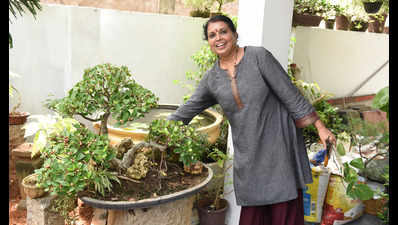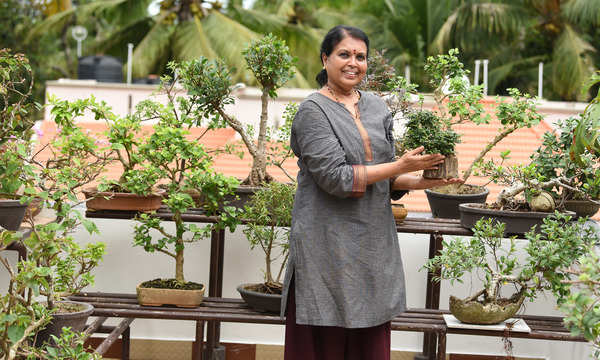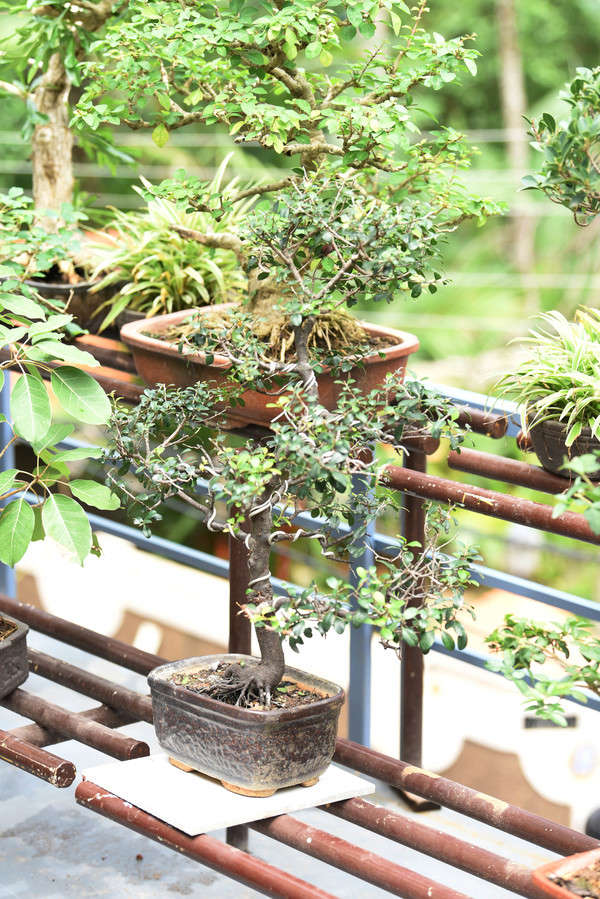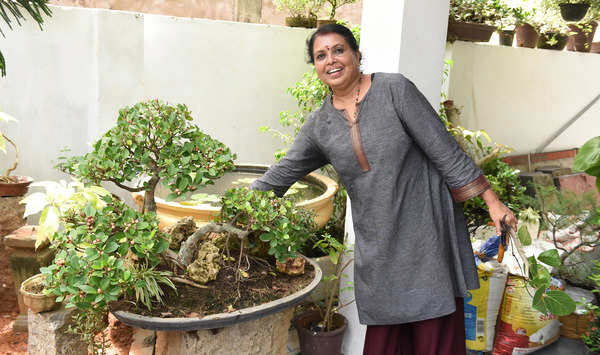- News
- City News
- kochi News
- A botanist and her bonsai garden
Trending
This story is from June 16, 2019
A botanist and her bonsai garden
Thiruvananthapuram-based Jaya P Nair has been nurturing a Bonsai garden for the past 25 years

Thiruvananthapuram-based Jaya P Nair has been nurturing a Bonsai garden for the past 25 years
Don’t throw away that tiny Banyan sapling that you find growing underneath your water tank or on a cracked wall, it could make a good Bonsai plant,” advises Jaya P Nair, an ardent Bonsai lover and the secretary of Kerala Bonsai Association. One is inclined to heed the advice as the comptroller at Raj Bhavan, Thiruvananthapuram, who is set to retire at the end of this month, practises what she preaches.
Jaya is currently busy shifting her 200 Bonsai plants from the comptroller quarters at Raj Bhavan to her house at Maruthankuzhy, and even as the renovation is in progress, she ensures that her Bonsai plants are given all the comfort they require. And why not, she has been growing them for the past 25 years.
These days, after work, she rushes to her Bonsai garden and takes each pot and places them with the utmost care on specially-made iron stands at her balcony. “I don’t want their environment to be disturbed too much as I have only recently shifted them from the space they have adapted for 25 years. One of the plants actually died due to it,” she says. Jaya’s Bonsai collection largely include Indian varieties of Ficus species as they are easier to grow in Kerala’s tropical climate. “They easily adapt as they need less water and sunlight to grow.”

While she says that Bonsai gardening can be expensive, she explains, “We could get a Bonsai from `500. One alone is enough if you love the plant. You could prune its small branches and create one by yourself in a pot. One can even grow the parasitic plants found in cracked walls or on big trees as a Bonsai plant. That way, we are also promoting green living. I would love to give the stems for free to those would love to make their own Bonsai plants.”
Growing Bonsai could also be a new mode to enhance greenery in urban buildings, she says.
“We now have space constraints in apartments. So, growing even two Bonsai plants on the balcony is enough to start a green living.”
On the process of growing a Bonsai plant, she says, “Nurturing a Bonsai plant is similar to growing life size plants. It may take years to see the plant turn into a good Bonsai as it follows its natural lifecycle. The taproots are cut initially, and we nurture the surface roots of the tree species, which results in the miniature version of the plant.”




A Bonsai plant must always be grown in one of the three triangular shapes — acute, obtuse and scalene, she says. “Add mud, sand and manure in equal proportions. For manure, one can use neem cake or diluted cow dung which would help them grow fast and healthy. Most importantly, keep in mind that Bonsai is not an indoor plant.”
Jaya, whose plan is to spread the Bonsai culture in the State, is excited about her life after retirement. “I want to concentrate more on my Bonsai gardening and for the next six months, I will be occupied with them. I can guarantee that if you can grow a Bonsai plant, you will grow patient, develop perseverance and attain peace of mind. I had gone through a lot of professional as well as personal stress and what helped me keep a clear mind through all of that were my Bonsai plants. I would highly recommend this to the young generation, especially boys, as it will help them become tolerant, responsible and help them control their short temper that is often seen in most men nowadays.”
Photo courtesy: Satheeshan Karicheri
Jaya is currently busy shifting her 200 Bonsai plants from the comptroller quarters at Raj Bhavan to her house at Maruthankuzhy, and even as the renovation is in progress, she ensures that her Bonsai plants are given all the comfort they require. And why not, she has been growing them for the past 25 years.
These days, after work, she rushes to her Bonsai garden and takes each pot and places them with the utmost care on specially-made iron stands at her balcony. “I don’t want their environment to be disturbed too much as I have only recently shifted them from the space they have adapted for 25 years. One of the plants actually died due to it,” she says. Jaya’s Bonsai collection largely include Indian varieties of Ficus species as they are easier to grow in Kerala’s tropical climate. “They easily adapt as they need less water and sunlight to grow.”

Jaya’s love for Bonsai first blossomed when she attended an exhibition at Kanakakunnu in the late 90s. “Being a Botany graduate, I was into plants and I was smitten by Bonsai and its greenery. I also got inspired by my friends, who are Bonsai lovers and that’s how I started collecting my own plants. It’s hard at first but we learn to be patient, just to see the plants grow,” says Jaya, who also owns foreign plants such as Beggars Bowl, Baobab, candle tree and the ornamental plant Pony Tail palm.
While she says that Bonsai gardening can be expensive, she explains, “We could get a Bonsai from `500. One alone is enough if you love the plant. You could prune its small branches and create one by yourself in a pot. One can even grow the parasitic plants found in cracked walls or on big trees as a Bonsai plant. That way, we are also promoting green living. I would love to give the stems for free to those would love to make their own Bonsai plants.”
Growing Bonsai could also be a new mode to enhance greenery in urban buildings, she says.
“We now have space constraints in apartments. So, growing even two Bonsai plants on the balcony is enough to start a green living.”
On the process of growing a Bonsai plant, she says, “Nurturing a Bonsai plant is similar to growing life size plants. It may take years to see the plant turn into a good Bonsai as it follows its natural lifecycle. The taproots are cut initially, and we nurture the surface roots of the tree species, which results in the miniature version of the plant.”




A Bonsai plant must always be grown in one of the three triangular shapes — acute, obtuse and scalene, she says. “Add mud, sand and manure in equal proportions. For manure, one can use neem cake or diluted cow dung which would help them grow fast and healthy. Most importantly, keep in mind that Bonsai is not an indoor plant.”
Jaya, whose plan is to spread the Bonsai culture in the State, is excited about her life after retirement. “I want to concentrate more on my Bonsai gardening and for the next six months, I will be occupied with them. I can guarantee that if you can grow a Bonsai plant, you will grow patient, develop perseverance and attain peace of mind. I had gone through a lot of professional as well as personal stress and what helped me keep a clear mind through all of that were my Bonsai plants. I would highly recommend this to the young generation, especially boys, as it will help them become tolerant, responsible and help them control their short temper that is often seen in most men nowadays.”
Photo courtesy: Satheeshan Karicheri
End of Article
FOLLOW US ON SOCIAL MEDIA










